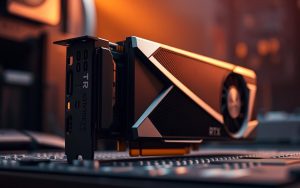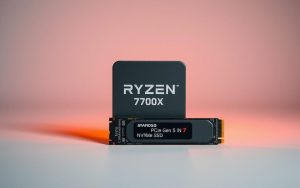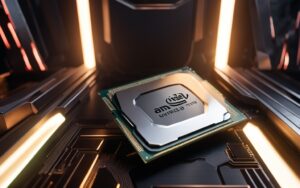Table of Contents
The next leap in storage technology is here. With blazing-fast speeds, PCIe 5.0 SSDs redefine performance for gaming, content creation, and data-heavy tasks. To harness their full potential, you need the right hardware.
Modern platforms like Intel’s 13th-gen CPUs and AMD’s Ryzen 7000-series are built for this upgrade. Pairing them with a compatible motherboard ensures seamless integration. Brands like ASUS, MSI, and GIGABYTE lead the charge with cutting-edge designs.
Future-proofing your build is key. Investing in DDR5 memory and PCIe 5.0 slots guarantees longevity. For top-tier recommendations, check our guide on the best motherboards available now.
Why Gen 5 NVMe SSDs Demand PCIe 5.0 Motherboards
Unlocking the full potential of next-gen storage requires the right foundation. PCIe 5.0 doubles the bandwidth of PCIe 4.0, hitting 32 GT/s transfer rates. This leap ensures SSDs like the MP700 PRO achieve speeds up to 14,000 MB/s—but only with compatible hardware.
Understanding PCIe 5.0 Bandwidth and Compatibility
Every PCIe 5.0 x4 slot delivers four lanes of high-speed data flow. Older PCIe 4.0 or 3.0 slots bottleneck performance, cutting speeds by 50–70%. For example, a Gen5 SSD in a PCIe 4.0 slot might max out at 7,000 MB/s.
Backward Compatibility vs. Full Performance
While newer SSDs work in older slots, you sacrifice speed. Thermal management also becomes critical. Gen5 SSDs generate more heat, demanding robust cooling solutions like heatsinks or airflow-optimized M.2 designs.
Balancing PCIe lanes is another challenge. High-end GPUs and NVMe storage compete for bandwidth. Some boards split lanes, reducing GPU performance when multiple SSDs are used. Check your chipset specs to avoid surprises.
Older Intel Z690 or AMD X670E boards may need BIOS updates to enable PCIe 5.0 support. Always verify compatibility before upgrading.
What Motherboards Support Gen 5 NVMe: Intel’s Top Picks
Intel’s latest platforms bring cutting-edge performance with PCIe 5.0 compatibility. Whether you’re pushing framerates or editing 8K video, these boards balance speed and reliability.

ASUS ROG MAXIMUS Z790 APEX ENCORE
Built for overclockers, this motherboard features dual PCIe 5.0 M.2 slots and supports DDR5-8000+ memory. Its ROG DIMM.2 card adds two extra PCIe 4.0 slots, totaling five M.2 drives.
AI Overclocking and advanced cooling ensure stability under heavy loads. Perfect for gaming rigs or workstation builds.
MSI and GIGABYTE Flagships
- MSI MEG Z790 GODLIKE: Quad M.2 slots and Wi-Fi 6E for max storage and connectivity.
- GIGABYTE Z790 AORUS MASTER: 10-layer PCB design enhances signal clarity for PCIe 5.0 x16 GPUs and SSDs.
ASRock’s Budget-Friendly Options
The Z790 PG RIPTIDE offers a PCIe 5.0 x16 slot and triple M.2 drives at a lower cost. Ideal for builders prioritizing value without sacrificing speed.
Looking ahead, Intel’s LGA 1851 socket (2025) will debut with Z890 chipsets, retaining cooler compatibility while adding more lanes. Early adopters should check BIOS updates for seamless transitions.
AMD Motherboards Ready for Gen 5 NVMe SSDs
AMD’s AM5 platform brings next-level performance with PCIe 5.0 compatibility. These boards are built for speed, offering seamless integration with Ryzen 7000-series CPUs. Whether you’re a gamer or a creator, AMD’s lineup delivers cutting-edge features.
ASUS ROG STRIX X670E-E GAMING and Premium Choices
The ASUS ROG STRIX X670E-E stands out with dual PCIe 5.0 x16 slots and two Gen5 M.2 slots. Its 18+2 power phases ensure stable overclocking, while Wi-Fi 6E keeps you connected. Perfect for high-end builds.
For creators, the ASUS ProArt X670E offers dual USB4® ports and 10 Gb Ethernet. It’s a powerhouse for 4K editing and multitasking.
MSI and GIGABYTE’s AM5 Powerhouses
MSI MEG X670E ACE features an 18+2 power design and advanced cooling. It supports PCIe 5.0 for both GPUs and storage. Wi-Fi 6E and 10 Gb Ethernet make it a top pick.
GIGABYTE X670E AORUS PRO X shines with its EZ-Latch design for easy upgrades. It balances performance and affordability, ideal for mid-range builds.
ASRock’s Competitive B650E and X670E Lineup
Budget builders will love the ASRock B650E PG RIPTIDE WIFI. It includes a PCIe 5.0 x16 slot and Wi-Fi 6E. Despite its lower price, it doesn’t skimp on features.
The X670E Steel Legend offers robust power delivery and triple M.2 slots. It’s a solid choice for gamers and professionals alike.
| Model | Key Features | Price Range |
|---|---|---|
| ASUS ROG STRIX X670E-E | Dual PCIe 5.0 x16, Wi-Fi 6E | $400-$500 |
| MSI MEG X670E ACE | 18+2 power phases, 10 Gb Ethernet | $500-$600 |
| ASRock B650E PG RIPTIDE | PCIe 5.0 x16, Wi-Fi 6E | $200-$300 |
AMD’s X870E chipset takes things further with AI-ready features and optimized lane allocation. Boards like the ASUS ROG Crosshair X870E HERO offer three Gen5 M.2 slots and USB4® support.
Key Features to Look for in a PCIe 5.0 Motherboard
Choosing the right components ensures your system stays ahead of the curve. A PCIe 5.0-ready board maximizes speed, efficiency, and longevity. Focus on these critical features to optimize your build.

M.2 Slot Configuration and Cooling Solutions
High-speed M.2 slots need robust thermal management. Brands like ASUS and MSI offer innovative designs:
- ASUS Q-Latch: Tool-free installation with integrated heatsinks for PCIe 5.0 SSDs.
- MSI Shield Frozr: Aluminum covers reduce throttling by 15°C under load.
For expandability, ASUS’s ROG DIMM.2 card adds two extra PCIe 4.0 slots. This is ideal for content creators needing multiple drives.
DDR5 Memory Support and Future-Proofing
DDR5 compatibility is non-negotiable for bandwidth-hungry tasks. Look for boards supporting DDR5-6400+ to avoid bottlenecks with next-gen graphics cards.
Key considerations:
- PCIe 5.0 x16 slots with metal reinforcement (e.g., ASUS SafeSlot) handle heavy GPUs.
- USB4®/Thunderbolt™ 4 ports for 40 Gbps transfers and 8K display support.
- BIOS Flashback™ and Q-Code debug LEDs simplify troubleshooting.
Balancing storage and GPU lanes is critical. Some boards split PCIe lanes, so check specs if using multiple SSDs.
Future-Proofing Your Build: Beyond 2025
Staying ahead means preparing for tomorrow’s tech today. The shift to PCIe 5.0 is accelerating, with mid-range chipsets like AMD’s B850 and Intel’s B860 expected to adopt it by 2026. These boards will bring cutting-edge speeds to budget-conscious builders.

Emerging standards are redefining connectivity. USB4® 40Gbps and Wi-Fi 7 ensure lightning-fast transfers, while NPUs (Neural Processing Units) handle AI tasks efficiently. Intel’s B860 series, for example, includes NPU Boost for seamless machine learning.
Multi-GPU setups are gaining traction with PCIe 5.0 bifurcation. Boards like the ASUS ROG Crosshair X870E HERO split x16 slots into dual x8 lanes, optimizing performance for graphics-intensive workflows.
For content creators, prioritize boards with:
- Dual Gen5 M.2 slots (e.g., MSI MEG X670E ACE)
- 18+2 phase power designs for next-gen CPUs
- RGB lighting zones for customization
Power delivery is critical. High-core-count CPUs demand robust VRMs. Look for designs with reinforced PCIe 5.0 x16 slots and advanced cooling to handle sustained loads.
Conclusion
Future-ready systems demand hardware that keeps pace with innovation. Flagship boards like the ASUS ROG MAXIMUS Z790 and ASUS ROG STRIX X670E-E deliver PCIe 5.0 x16 slots and Gen5 M.2 support, ensuring peak speeds for 2025 and beyond.
Pair these with MP700 PRO SSDs for unmatched performance. Always verify lane configurations to avoid bottlenecks, especially with multi-drive setups.
For AM4 or LGA1700 users, consider upgrading to AM5/LGA1851 platforms to fully leverage next-gen storage. Investing wisely today means staying ahead tomorrow.
FAQ
Which Intel motherboards support PCIe 5.0 M.2 slots?
High-end models like the ASUS ROG MAXIMUS Z790 APEX ENCORE and MSI MEG Z790 GODLIKE offer PCIe 5.0 x16 slots and Gen 5 NVMe support. Budget-friendly options include ASRock’s Z790 Taichi Lite.
Are AMD AM5 motherboards compatible with Gen 5 SSDs?
Yes, premium boards like the ASUS ROG STRIX X670E-E GAMING and GIGABYTE X670E AORUS MASTER feature PCIe 5.0 M.2 slots. Even mid-range B650E models from ASRock provide this capability.
Do PCIe 5.0 motherboards work with older PCIe 4.0 SSDs?
Absolutely. PCIe 5.0 slots are backward compatible, but Gen 4 drives will run at their native speeds, not the full bandwidth of 5.0.
What cooling solutions are needed for Gen 5 NVMe SSDs?
High-performance heatsinks or active cooling are recommended, as PCIe 5.0 M.2 drives generate more heat than previous generations. Many premium boards include integrated thermal guards.
Is DDR5 memory required for PCIe 5.0 motherboards?
While not mandatory, DDR5 optimizes performance in modern builds. Most Intel Z790 and AMD X670E/B650E boards exclusively support DDR5.
Can I use a PCIe 5.0 GPU and SSD simultaneously?
Yes, but bandwidth allocation varies. High-end boards like the MSI MEG X670E ACE split lanes to support both without bottlenecks.
Are there budget PCIe 5.0 motherboards for AMD Ryzen?
ASRock’s B650E Steel Legend and GIGABYTE B650E AORUS Elite offer Gen 5 M.2 slots at competitive prices, balancing cost and future-proofing.









